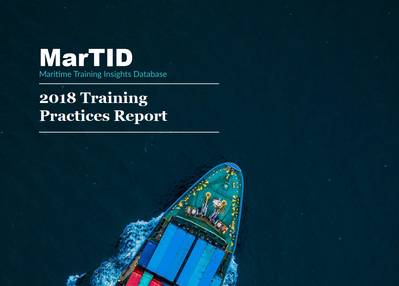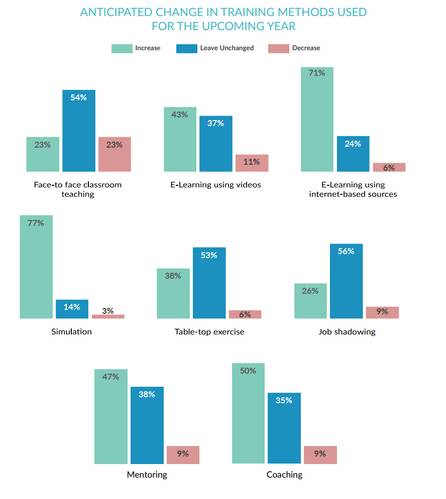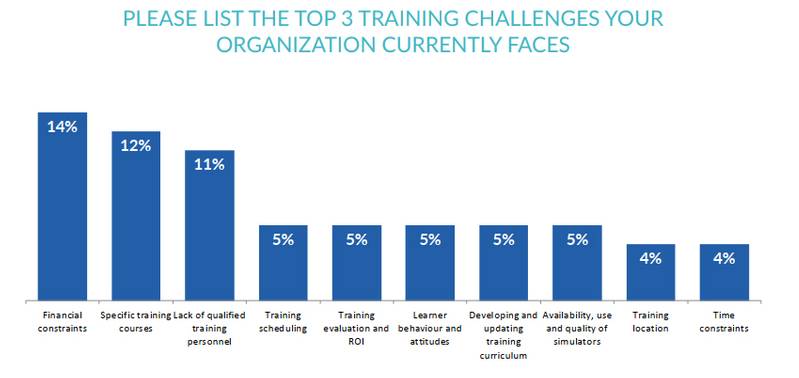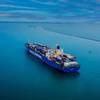Transformation in Maritime Industry Training
The 2019 Maritime Insights Database (MarTID) survey has just been launched. This annual survey and the resulting annual reports (available freely at www.MarTID.org) provide critical data on maritime training practices and trends useful to every segment of the maritime industry. As such, it is important that every seafarer, maritime trainer and maritime administrator working at a vessel operator or training center complete the survey (also available at www.MarTID.org) and ask their colleagues to do the same.
Now that the 2019 survey has been launched, it is useful to examine the most notable insights revealed by the inaugural 2018 report. It turns out that there is one message that, far and away, stands out most in the report. That message is that we are, right now, in the throws of a major training transformation in the maritime industry. It is a transformation that swept other industries over the last 10 – 15 years, and that we are now experiencing here in our industry. And although there was anecdotal evidence of this transformation in the past, the MarTID report presents clear data that must be understood by everyone in the maritime industry – especially those involved in training. That data reveals a clear transformation away from traditional training practices, and toward modern learning technologies such as internet-based e-learning and simulation.
There are important messages here for all operators – both in terms of what is happening in the industry, and what it says about our acceptance of non-traditional practices in the industry. It will affect the industry across a variety of domains – operational, regulatory, budgetary, and of course training. Understanding this trend, the evidence for it and the reasons for it allows vessel operators, training centers and even seafarers to both prepare for the transformation and take best advantage of it. It is a transformation that affects us all – so let’s look at the data.
The Findings
The trend toward modern training tools and practices in the maritime industry did not begin yesterday. Over many years the industry has slowly become more and more aware and accepting of new tools and techniques, despite our reputation for favoring traditional techniques and the status quo. This, in itself, is an important message to take away – that despite our reputation, the industry is indeed accepting of new ideas when they are well supported by evidence.
The most obvious evidence of the trend toward the adoption of learning technologies such as simulation and eLearning is the degree to which these technologies have already been adopted. Given how recently they have become available, it is remarkable to note that they have already been adopted by roughly 90% of respondents. Compare this to the situation of the early 1990s when simulation and eLearning barely existed. This is clear evidence of a rapid transformation.
 A whopping 70% to 80% of MarTID survey respondents plan to increase their usage of simulation and internet-based eLearning in the upcoming year.But even more important than the current level of use is the rate at which these technologies continue to be adopted and more deeply implemented. A whopping 70% to 80% of MarTID survey respondents plan to increase their usage of simulation and internet-based eLearning in the upcoming year. Of all training techniques surveyed, these two were the clear stand-outs in terms of plans for increased usage. It is similarly interesting to note that only 3% to 6% of respondents indicated that they planned to decrease their usage of those same technologies. No other training technology came close in terms of plans for increased use, and every other training technique is slated for a larger decrease amongst respondents. So not only have we experienced a significant transformation, but that transformation is, in fact, still in full swing.What Does this
A whopping 70% to 80% of MarTID survey respondents plan to increase their usage of simulation and internet-based eLearning in the upcoming year.But even more important than the current level of use is the rate at which these technologies continue to be adopted and more deeply implemented. A whopping 70% to 80% of MarTID survey respondents plan to increase their usage of simulation and internet-based eLearning in the upcoming year. Of all training techniques surveyed, these two were the clear stand-outs in terms of plans for increased usage. It is similarly interesting to note that only 3% to 6% of respondents indicated that they planned to decrease their usage of those same technologies. No other training technology came close in terms of plans for increased use, and every other training technique is slated for a larger decrease amongst respondents. So not only have we experienced a significant transformation, but that transformation is, in fact, still in full swing.What Does this
Mean for Maritime Training?
What inferences can we derive from these numbers? First, it is reasonable to infer that respondents are highly satisfied with their use of these technologies. There is already a high degree of use, and those respondents plan to increase their usage. Additionally, only a very small number of respondents have plans to decrease usage next year.
Other inferences can be derived by comparing respondents’ plans for learning technologies with those of more traditional models such as job shadowing and classroom-based training. These are two training models that respondents indicated would be expanded upon the least at 26% and 23% respectively. Equally interestingly, for classroom training, the same percentage of respondents (23%) indicated that they expected to do less next year. Thus according to this data, at this point the usage of classroom training is flat while every other model surveyed is on the increase. This is significant as it indicates a trend away from traditional models and toward modern technologies.
This trend will cause changes and even disruption over the coming years. Currently, the most-used model of training is classroom-based training; 92% of respondents indicate they use it a medium to high amount and 43% indicate that it is their primary training method. According to the data, this is going to change, and generally, the change will be for the better.
Knowledge training has been shown to be more efficient and effective using on-line models where the training inherently adapts to each individual learner and learning style. This is in opposition to face-to-face classes where the timing of the lecture and the experience the trainees have is uniform. This model does not account for individual differences in the trainees and therefore it is more likely that the outcomes will be poorer and vary more widely. Thus, the move toward online learning for knowledge acquisition portends a future of better trained seafarers.
Addressing Training Challenges
In addition to a future with potentially better training outcomes, a move to technology-enabled training will also, in part, address the top three training challenges listed by MarTID survey respondents.
The most commonly cited challenge is the presence of financial constraints. Although implementing an eLearning program does not come for free, once developed it presents a much more efficient (and less expensive) training model. This is especially true in cases where it removes or reduces the need to transport trainees or instructors to training centers.
The second and third most commonly cited training challenges are lack of training courses and lack of qualified training personnel. Fortunately, for knowledge-based courses there is a growing body of eLearning content creators and a growing library of good quality web-based learning materials. Additionally, we have seen some of our customers to collaborate on the creation of online training materials and share the costs. They do not see improved safety as a competitive advantage but rather a rising tide that lifts all ships. We have also seen, in other industries, large and mature open-source libraries of free on-line learning materials. This movement is especially advanced in higher education where multiple initiatives provide quality learning materials to be freely used by individuals and deployed by organizations. There is no reason this cannot happen in the maritime industry.
Of course, learning technologies will not solve all training and assessment problems. It is true that web-based eLearning can improve both the efficiency and effectiveness of knowledge training, and that simulators can greatly support the acquisition of skills. However, no training program can be successful without the presence of an expert trainer who is available to interact with the trainees, reinforce skills, share experiences, and mentor students. So, at no time in the foreseeable future will the need for expert, face-to-face instruction disappear. It will, however, change and be more effective.
















